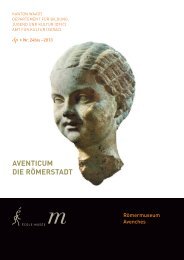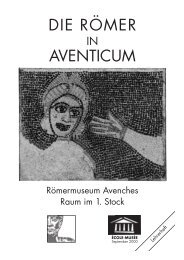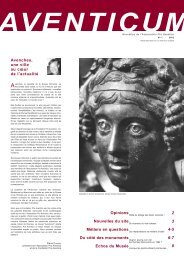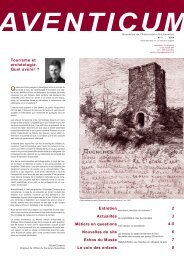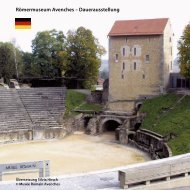Avenches – Roman Museum – Permanent Exhibition
Avenches – Roman Museum – Permanent Exhibition
Avenches – Roman Museum – Permanent Exhibition
Create successful ePaper yourself
Turn your PDF publications into a flip-book with our unique Google optimized e-Paper software.
First Floor Theatre, Games and Music<br />
the dancers did not wear any masks and sang the verses themselves. Instead of<br />
referring to Greek mythology, the subjects presented were based on real events<br />
and were inspired by everyday life. In general, the performances were comic and<br />
sometimes even vulgar.<br />
Display case 11<br />
1. Mosaic depicting the scene of a play, with two actors, one of whom is wearing a comic<br />
mask representing a young girl.<br />
Display case 12<br />
1. Funerary mask of a tragic heroine, limestone. Early 2nd century AD.<br />
2. Satyr mask on a marble relief. Last quarter of the 1st century AD.<br />
3. Terra-cotta antefix decorated with a mask.<br />
4. Ivory box in the shape of a comic mask. 1st <strong>–</strong> 2nd centuries AD.<br />
5. Bronze statuette of tragic actor (p. 28, 1); his belt shows an inscription, probably<br />
Dovecus which might be his name. Early 3rd century AD. Catalogue of inscriptions: no. 22.<br />
6-9. Medallions of various terra-cotta oil lamps decorated with comic masks (1).<br />
In the amphitheatre one watched gladiatorial combat (munera) where two men<br />
fought to the death (display case 13, nos. 1-9) to the sound of horns or organs<br />
(display case 14, no. 7). As a rule, gladiators were slaves, prisoners of war, criminals<br />
sentenced to death or young men from noble families who had fallen from grace<br />
and had been attracted by fame and easy money. They were trained in barracks<br />
specifically built for that purpose (ludi).<br />
Hunting scenes (venationes) (display case 13, no. 11) were also staged in sets<br />
representing wilderness. Wild animals were set on each other, for instance large<br />
game on dear, lions (display case 13, no. 12) on tigers, bears on bulls (display case 13,<br />
no. 10), or men on animals such as bulls, bears, panthers, tigers or lions.<br />
The circus was another form of entertainment, but so far no such structure has<br />
been discovered at Aventicum. A circus was mainly used for chariot races, but also<br />
for sports competitions such as boxing, wrestling or running.<br />
Display case 13<br />
1. Fighting gladiator (2). Lead glazed pottery decoration, originally part of a vessel.<br />
Mid 1st century AD.<br />
2. Ivory handle of a flick knife decorated with two gladiators (p. 30, 1). 3rd century AD.<br />
3. Gladiator. Bronze statuette. 2nd <strong>–</strong> 3rd centuries AD.<br />
4. Gladiator. Bronze fitting.<br />
5. Fragment of glass goblet, depicting scenes of gladiatorial combat. Two names of<br />
gladiators are partly preserved: (Colu)mbus and (Calam)us.<br />
6. Fragment of glass goblet, depicting scenes of gladiatorial combat. Three names are<br />
partly preserved (Calam)us, Orie(n)s and Petr(aites).<br />
1<br />
2<br />
29<br />
First Floor<br />
11<br />
12<br />
13<br />
14



